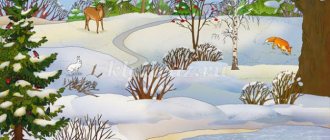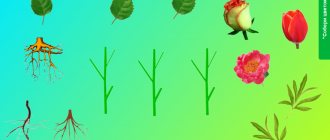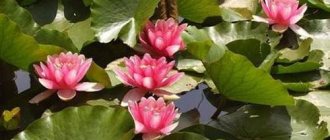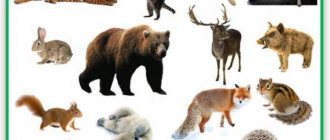Master class on creating a lapbook “Wild Animals”
Let's consider the option of compiling a lapbook, which can be called basic: it does not require much time to design it - it is made on the basis of a folder for storing files, and the form of organization of materials allows you to use the manual for several years, simply changing the contents of the envelopes.
You can add new materials to a lapbook based on a thick file folder without removing old ones - the dimensions allow
Materials and tools:
- thick file folder,
- envelope folders with buttons (different formats),
- scissors,
- glue gun,
- wide tape,
- double sided tape,
- colored cardboard,
- glue,
- printed names of the blocks of the manual,
- Pictures.
Instructions:
- On the front of the outer part of the folder we glue a picture with the caption “Lapbook Wild Animals”. It’s better to use wide tape for this: attach the picture and lay the tape on top. It is important to ensure that there are no air bubbles and that the tape does not bunch up.
For durability, pictures and names should be taped with tape.
- You can also stick the title of the manual on the spine.
- On the left flap we place ready-made plastic envelopes for game materials and texts for reading and retelling.
To rationally use the base folder, envelopes need to be selected in different formats
- On the right flap we have figuratively cut pockets for games, riddles, pictures, as well as finger gymnastics texts.
Envelopes can be signed with a felt-tip pen in a contrasting color or cards with printed names can be glued on
- We attach two envelopes with buttons to the outside of the folder at the back: one for coloring books, the second for pictures for the game.
Usually the envelopes on the back contain games or coloring books.
Photo gallery: samples of lapbooks on the theme “Wild Animals”
The younger the children, the more pictures the laptop should contain and the less text.
To decorate the folder, you can use self-adhesive, stylized wood
Pockets and envelopes must be signed
Pictures are used not only as teaching material, but also as a means of designing a manual.
For the spinning drum, you can choose a task to match the animal with its tail
The higher the level of knowledge of the children, the more blocks there can be in the manual
Video: review of materials for the “Wild Animals” lapbook
Important aspects of compiling a lapbook “Wild Animals”
The compilers of the manual can be either teachers, if the lapbook is intended for children of younger groups, or parents, for example, if creating a lapbook is a project task in kindergarten, or mom and dad want to systematize the materials they use with their child. In any case, the manual will work much more effectively if children are involved in its creation . Toddlers and children of middle preschool age can arrange and glue pictures, and students in older groups can even participate in compiling a selection of materials.
Classes with a laptop teach children to independently find solutions and draw conclusions
Choosing a theme
The topic “Wild Animals” is very broad, so it is more practical to narrow down the topics covered, for example:
- "Wild Animals of Russia"
- "Wild animals of our native land"
- "Wild animals of central Russia",
- "Exotic animals",
- "Groups of animals by type of nutrition."
Benefit form
For the “Wild Animals” lapbook, you can use the following forms of organizing materials:
- a mobile folder with 3-4 opening spreads or two doors - traditionally, materials for younger groups are organized in this way, since the manual for this age is dominated by pictures, and the shape of the slide allows you to view all the illustrations at once,
- a folder cut out according to the silhouette of an animal, for example a bear,
- accordion folder - this is usually how materials for older preschoolers are designed, since younger ones can get confused with opening and closing pages.
Which method and format of organizing a laptop to choose?
Pockets are the most convenient way to organize information in a manual. This option for storing materials is especially in demand for children of primary and secondary preschool age. But for older preschoolers, you can also use envelopes that close with a “tab” on the top flap, which fits into the hole on the envelope.
Blocks of materials can be stored:
- in envelopes with curly silhouettes (for example, cones or baskets for organizing materials related to food for wintering animals),
Even if the manual assumes the presence of shaped envelopes, the basis should still be ordinary ones, since they are the most convenient and practical
- in folding books for the design of riddles, poems or proverbs, sayings, as well as under pictures with texts for practicing the correct names of male, female and baby animals,
- in the doors, for example, in a laptop for kids, this is how you can arrange a poem, which is the basis of the information block of the entire manual,
- in the windows - usually thematic pictures depicting animals, their habitats and cubs are placed in this way,
- on spinning reels, where the arrows are positioned so that one points to the beast and the other to the “child”.
As when creating manuals on other topics, all materials - texts, pictures - are placed on cards.
The format for submitting information can be in the form:
- puzzles,
- illustrations (without text for children to write descriptions or for designing an information block),
- games,
- poems,
- riddles (for the first younger group this block is not needed, and in the second group riddles are given with answers in rhyme),
- proverbs, sayings (this block is included only in manuals for older preschoolers),
- coloring books (for kids, drawings should have large elements),
- discs with audio and video materials on the topic (recordings of sounds made by animals, educational cartoons, presentations).
Options for using the manual in a group and at home
As mentioned earlier, the benefit can be used not only in kindergarten, but also at home. Moreover, at different stages of consideration of the topic: when familiarizing themselves with the material, children can describe pictures and memorize poems. In the process of practicing the material - play, color, solve puzzles.
In this case, work can be organized both individually and in a group.
When preparing a lesson, the teacher can use a lapbook at each stage of the GCD. For example, to update basic knowledge, you can use riddles, at the main stage of the lesson - games, work with pictures, texts of fiction, and at the final stage - puzzles and/or coloring books.





